LSAT Forum
3 postsPage 1 of 1
-

- timmydoeslsat
-
Thanks Received: 887
-
Atticus Finch

- Posts: 1136
- Joined: June 20th, 2011
- This post thanked 1 time.

- Most Thanked

- First Responder
Re: Q9
I believe the reason for the troubles on this game, or at least these two questions, may be the set up.
I will be thorough in my explanation and the thought process I had when I sat down to do this game.
After reading the logic game prompt without reading the indented rules, I had this as my set up.
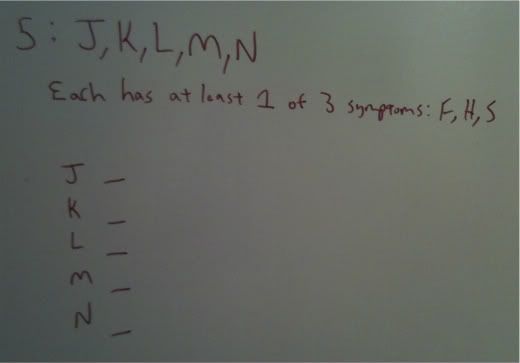
I chose the illnesses (5 of them) as the base of my set up. This is because I know that each of them contains at least 1 symptom. There are 3 symptoms available to us. However, at this point, there is nothing telling me that I must use all 3 or even two of them. Too much uncertainty using the symptoms as the base. I know the illnesses must be used, as each has at least 1 symptom.
As of now, I simply place a slot next to each illness because I know they have at least one symptom of F H S.
Next, I go through the rules.
After reading rule 1, my diagram looks like this:
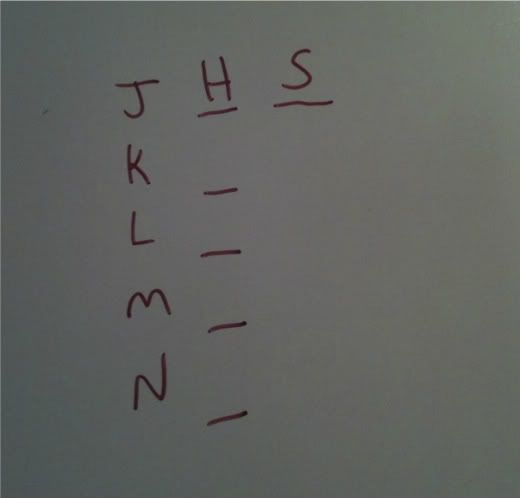
I know that J has H and S as symptoms. However, it does not say that it only has those symptoms, or is limited to those. For now, I cannot preclude the possibility of F also being a symptom for J. I keep that in mind.
After reading rule 2, my diagram looks like this:
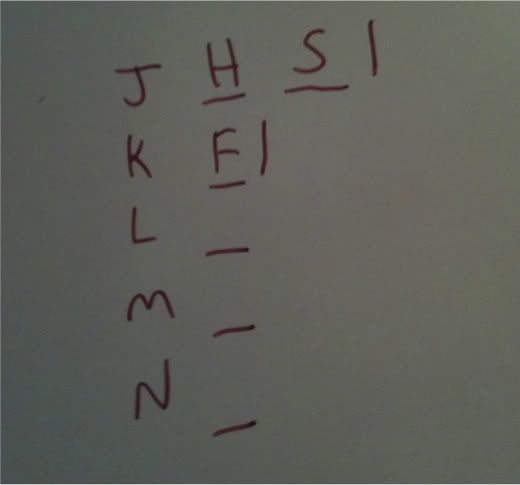
This rule told me that J and K have none in common. Since each illness has to have at least one symptom, and J has 2 of the symptoms, then K must have F. We also know that we can "wall-off" both J and K. We know exactly what they have. No chance that K could have 2 or 3 symptoms and no chance that J can have all 3 symptoms either.
After reading rule 3, my diagram looks like this:
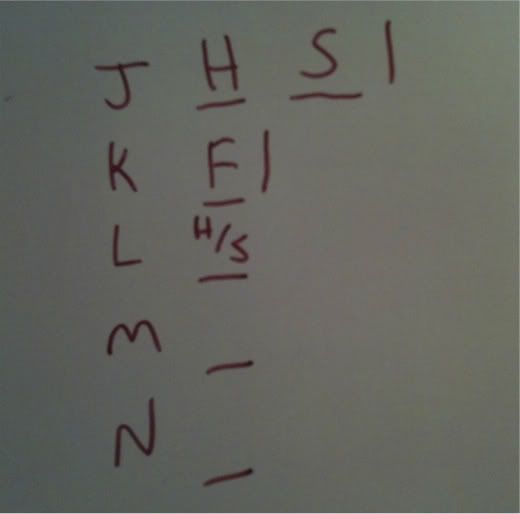
J and L have at least one symptom in common. I know that J has H and S, so L must have at least one of H and S. It could have both H and S. It could have all 3 as of now. I do not wall anything off.
After reading rule 4, my diagram looks like this:
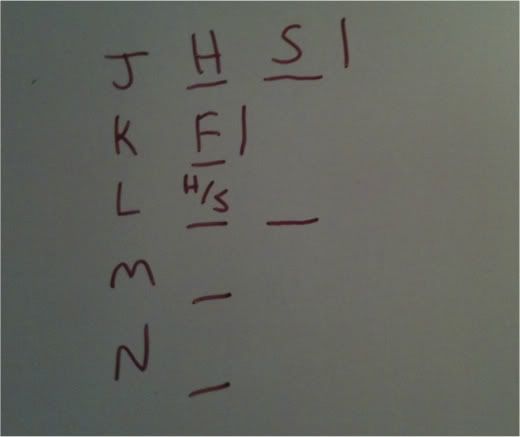
For L to have more symptoms than K, L must have at least 2 symptoms since K has one and only one symptom. I do not know what will encompass this second slot. I still could have 3 symptoms. This second slot could be the second of the H S combo, or it could contain an F while the first slot takes care of the "at least one of H S" concept we discussed earlier.
After reading rule 5, my diagram looks like this:
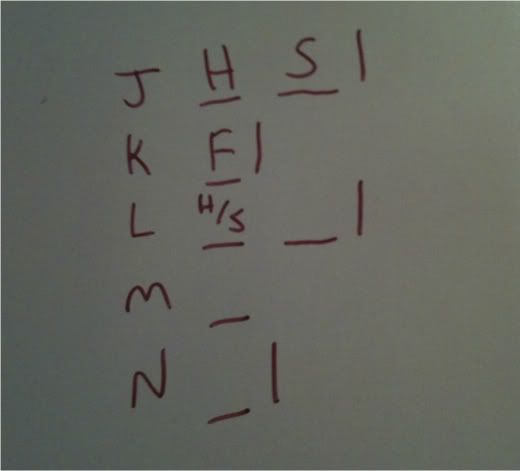
For L and N to have no symptoms in common, L must have only 2 symptoms and N can only have 1 symptom. We knew going into reading this rule that L had to have at least 2, but we now know that having all 3 symptoms is out of the question because L and N cannot share any symptom.
After reading rule 6, my diagram looks like this:
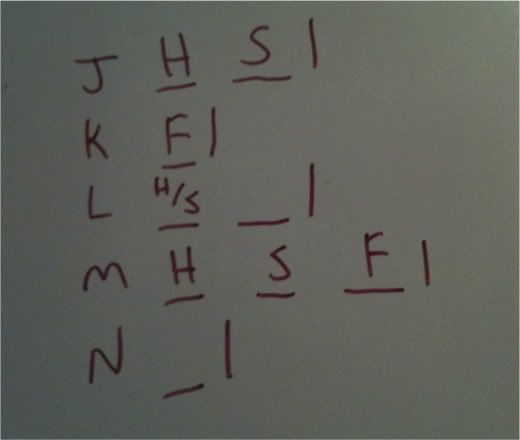
For M to have more symptoms than J, M must have all 3 symptoms because we know that J is walled off at 2 symptoms.
M has F H S.
Notice that after reading all of the rules and looking at our diagram, only 2 illnesses have uncertainty with them, and it is not a great amount of uncertainty. We know that L and N cannot share any. And each is walled off, so we know how many symptoms each contains.
I decided to show the only two possible scenarios for those 2 illnesses because experience tells me that this will put time in the bank to answer the questions. I mean think about it, these are the only 2 uncertain aspects in the game, you know the questions are going to address this.
My two scenarios of L and N:

When N has F, we know that L has H and S.
The only other scenario that exists is for L to have F and one of H and S, while N has the other variable of H and S.
Now, tell me if those questions do not look easier.
I will be thorough in my explanation and the thought process I had when I sat down to do this game.
After reading the logic game prompt without reading the indented rules, I had this as my set up.

I chose the illnesses (5 of them) as the base of my set up. This is because I know that each of them contains at least 1 symptom. There are 3 symptoms available to us. However, at this point, there is nothing telling me that I must use all 3 or even two of them. Too much uncertainty using the symptoms as the base. I know the illnesses must be used, as each has at least 1 symptom.
As of now, I simply place a slot next to each illness because I know they have at least one symptom of F H S.
Next, I go through the rules.
After reading rule 1, my diagram looks like this:

I know that J has H and S as symptoms. However, it does not say that it only has those symptoms, or is limited to those. For now, I cannot preclude the possibility of F also being a symptom for J. I keep that in mind.
After reading rule 2, my diagram looks like this:

This rule told me that J and K have none in common. Since each illness has to have at least one symptom, and J has 2 of the symptoms, then K must have F. We also know that we can "wall-off" both J and K. We know exactly what they have. No chance that K could have 2 or 3 symptoms and no chance that J can have all 3 symptoms either.
After reading rule 3, my diagram looks like this:

J and L have at least one symptom in common. I know that J has H and S, so L must have at least one of H and S. It could have both H and S. It could have all 3 as of now. I do not wall anything off.
After reading rule 4, my diagram looks like this:

For L to have more symptoms than K, L must have at least 2 symptoms since K has one and only one symptom. I do not know what will encompass this second slot. I still could have 3 symptoms. This second slot could be the second of the H S combo, or it could contain an F while the first slot takes care of the "at least one of H S" concept we discussed earlier.
After reading rule 5, my diagram looks like this:

For L and N to have no symptoms in common, L must have only 2 symptoms and N can only have 1 symptom. We knew going into reading this rule that L had to have at least 2, but we now know that having all 3 symptoms is out of the question because L and N cannot share any symptom.
After reading rule 6, my diagram looks like this:

For M to have more symptoms than J, M must have all 3 symptoms because we know that J is walled off at 2 symptoms.
M has F H S.
Notice that after reading all of the rules and looking at our diagram, only 2 illnesses have uncertainty with them, and it is not a great amount of uncertainty. We know that L and N cannot share any. And each is walled off, so we know how many symptoms each contains.
I decided to show the only two possible scenarios for those 2 illnesses because experience tells me that this will put time in the bank to answer the questions. I mean think about it, these are the only 2 uncertain aspects in the game, you know the questions are going to address this.
My two scenarios of L and N:

When N has F, we know that L has H and S.
The only other scenario that exists is for L to have F and one of H and S, while N has the other variable of H and S.
Now, tell me if those questions do not look easier.
-

- giladedelman
-
Thanks Received: 833
- LSAT Geek
- Posts: 619
- Joined: April 04th, 2010
Re: Q9
Wow, that was one of the gnarliest forum posts of all time! Seriously, that was better than any LG explanation I've posted on here. Thanks so much!
The only thing we would do differently (apart from putting the illnesses on the bottom, rather than the left -- totally a cosmetic difference) is start your diagram with the maximum number of slots, and narrow it down as you go. So each illness would have three slots, and as you start figuring out that, for example, J can't have all three, you can cross off that third slot for J.
Anyway, as for question 9: it's asking us what must be true if L has a unique set of symptoms, that is, if no one else has exactly what L has. Well, that means L can't have H and S, because that would make it exactly the same as J. So it must have H or S, plus F.
Hence answer (A) must be true.
The only thing we would do differently (apart from putting the illnesses on the bottom, rather than the left -- totally a cosmetic difference) is start your diagram with the maximum number of slots, and narrow it down as you go. So each illness would have three slots, and as you start figuring out that, for example, J can't have all three, you can cross off that third slot for J.
Anyway, as for question 9: it's asking us what must be true if L has a unique set of symptoms, that is, if no one else has exactly what L has. Well, that means L can't have H and S, because that would make it exactly the same as J. So it must have H or S, plus F.
Hence answer (A) must be true.
3 posts Page 1 of 1